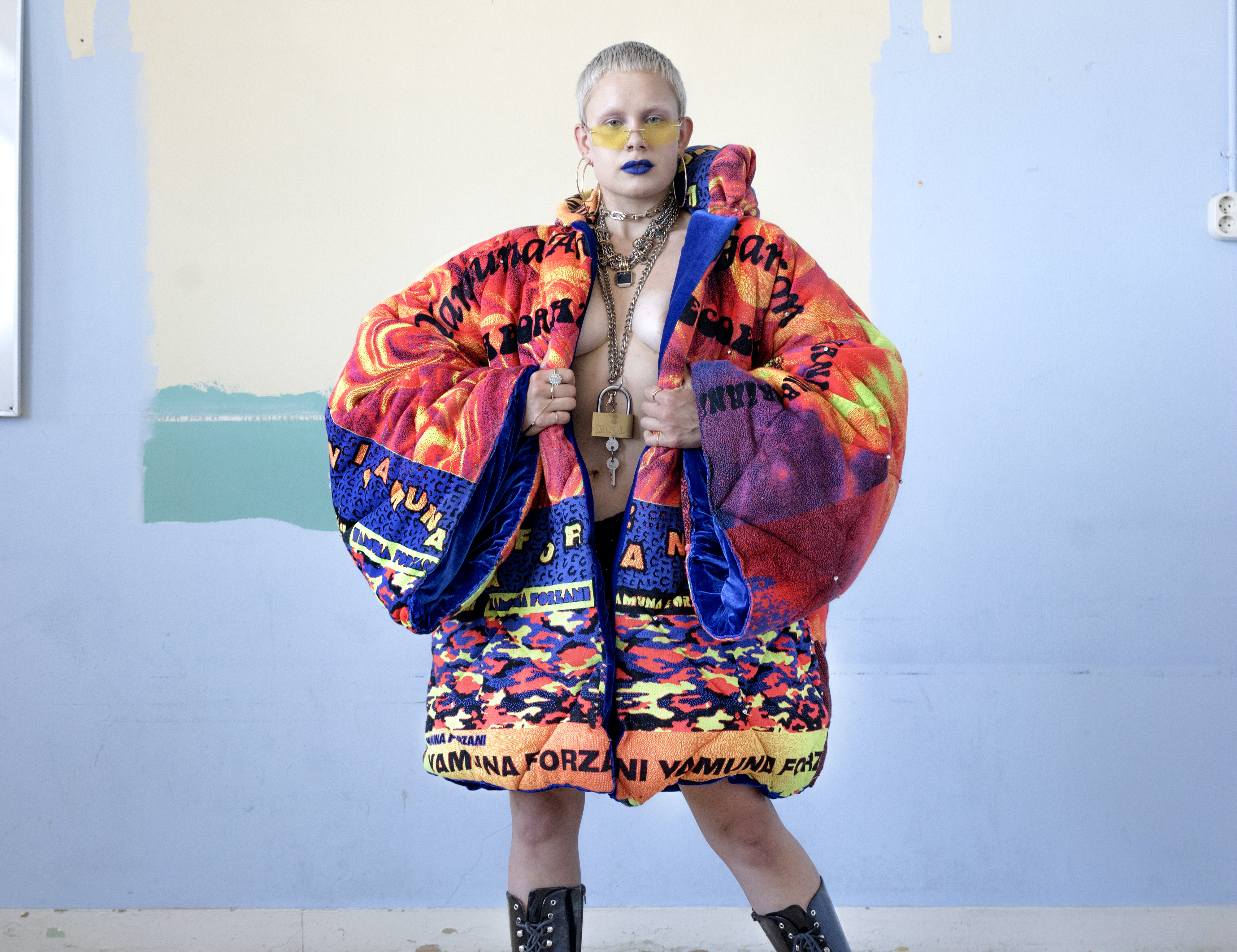Written by Jo Altmaier.
Art by Fashion designer Yamuna Forzani.
Navigating the dating world as a nonbinary person is tough. I often find myself shoved into a binary box for people’s own comfort — parents, teachers, strangers, and even fellow queer people. It feels like a prison. But how do you tell your romantic partner they’re guilty of it, too?
Dating apps like Tinder and Bumble let you list your gender as nonbinary. But then you have to choose who to be shown to: “Do you want to be shown to people looking for men or people looking for women?”. Or, how I read it: “Do you want to be categorized as basically a man or basically a woman?” We have to choose. There is no nonbinary option. No one is looking for us.
It gives me this guilty feeling at the bottom of my stomach. Am I being a bad nonbinary person for joining apps that exclude us? If I select “Be shown to people looking for men” despite not being one, am I perpetuating that harmful stereotype that trans/nonbinary people are “deceptive” or “tricking” cis people? If someone looking for women matches with me, will they be disappointed to find that I am not one? Or will they try to categorize me as “basically a woman” for their own comfort?
Dealing with blatant transphobes online is simple enough: Delete, report, block. But then there’s those more subtle transphobes — who you match with, are attracted to you and ask you for a coffee date, and are “okay” with your gender; who are nice and, for the most part, kind, but they don’t know how to use your pronouns. They say they don’t know how to introduce you to their friends, but they also refuse to educate themselves. Like Tinder, they categorize you as “basically a [insert binary gender here].”
Dealing with blatant transphobes online is simple enough: Delete, report, block. But then there’s those more subtle transphobes….
It sucks. It feels like absolute shit when this happens. So how do you prevent it? How do you stop it in its tracks? Communicate or break up. It’s harsh, but for your mental health, those are your only options. Here are some tips on how to do it. Make sure you are in a safe space, and have time — this conversation could last anywhere from 10 minutes to two hours.
1. Talk about labels, identity, and pronouns.
What is your gender and what pronouns are you comfortable with? How does this differ from other identities? Talk about the difference between sex and gender.
2. Talk about how being misgendered makes you feel.
What does it feel like when someone uses the wrong pronouns? I find it helpful to compare it to physical pain. Misgendering feels like a punch to the stomach. The type that leaves you queasy all day. Talk about how it affects you mentally, too. Personally, it makes me feel like I’m not being valued and listened to. It makes me lose confidence in your identity and a little more fearful of coming out to people in the future.
3. Talk about presentation.
Sometimes I present very feminine and sometimes I present very masculine. Whether I am wearing my bright pink fuzzy sweater or jeans and cowboy boots, I am still nonbinary. I still use they/them pronouns. I still deserve respect. So do you. If you’re non-binary, any presentation is valid because you are neither male nor female. Dressing in a way that society traditionally recognizes as very masculine or feminine doesn’t change that.
4. Discuss gender-neutral labels they can call you.
There is nothing more disheartening than meeting their friends for the first time and hearing, “So, this is your girlfriend/boyfriend?” when you are neither. Gender-neutral labels like “joyfriend,” “partner,” “significant other,” “my other half,” “lover,” or “enbyfriend” might be better. Get creative! Gender-neutral labels aren’t a new thing. People have been using them for a very long time.
5. Make the hard decision: Break up or stay together.
If your partner doesn’t take you seriously, if they don’t listen, if they continue to talk about you as their girlfriend/boyfriend, you should leave the relationship. Relationships thrive on mutual respect. No relationship can work without respect, and respecting your pronouns and gender identity is a basic and easy thing to do. if they don’t respect your gender and pronouns, they don’t respect you. Period.
If you need more help figuring out how to tell your partner not to use binary labels for you, I have also made a general fill-in-the-blank script for this conversation. Feel free to change it around as you see necessary:
“I want to talk to you about my gender and pronouns. Recently, I have noticed you using the wrong pronouns and referring to me in a way I am uncomfortable with. Being misgendered makes me feel ____. I am [gender]. I use [pronouns], and those only. Even if I am not around, you need to use those pronouns. I am also uncomfortable with you calling me your [girlfriend/boyfriend]. Good alternatives are [your favorite alternative]. If you can’t respect this, we can’t continue this relationship.”
Remember that you are not being too demanding for wanting respect. You are not being dramatic. You are not being abusive for needing the right pronouns.
About the Author
Jo Altmaier is an 18-year-old nonbinary writer and artist based in Colorado. Their dream is to spread as much positivity as possible with their art and slam poems. Their art focuses on queer issues, feminism, positivity, and living with hearing loss at a young age.
Follow on IG: @jo.altmaier | Follow on Twitter: @joaltmaier

